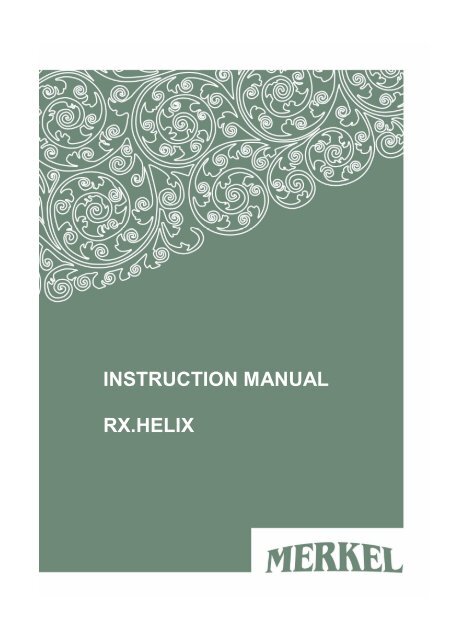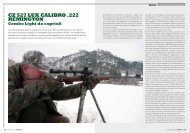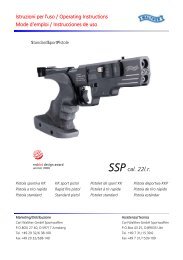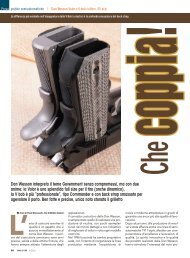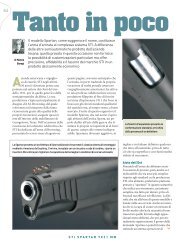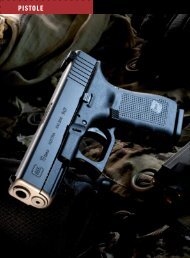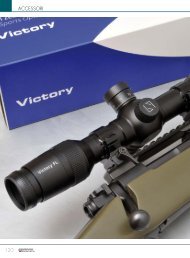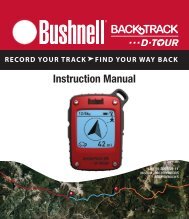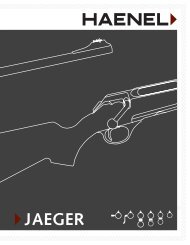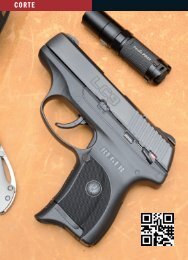INSTRUCTION MANUAL RX.HELIX - uri=merkel-die-jagd
INSTRUCTION MANUAL RX.HELIX - uri=merkel-die-jagd
INSTRUCTION MANUAL RX.HELIX - uri=merkel-die-jagd
You also want an ePaper? Increase the reach of your titles
YUMPU automatically turns print PDFs into web optimized ePapers that Google loves.
<strong>INSTRUCTION</strong> <strong>MANUAL</strong><strong>RX</strong>.<strong>HELIX</strong>
Table of Contents1 General1.1 How to use this Manual1.1.1 General1.1.2 Signs and Symbols1.2 Disclaimer1.3 Safety Instructions1.3.1 Safety guidelines for the use of firearms1.3.2 Safety mechanism (manual cocking)1.3.3 Ammunition2 Weapon Description and Handling2.1 Short Description / Specific Features2.2 Components2.3 Cocking / Uncocking the Weapon2.3.1 Cocking2.3.2 Uncocking2.3.3 Bolt lock2.4 Caliber Change2.4.1 Caliber groups2.4.2 Caliber change within the same caliber group (without changing bolt head)2.4.3 Caliber change with bolt head change2.5 Filling and Emptying of Magazine2.6 Loading the Weapon2.7 Shooting2.7.1 Preparing the rifle for firing2.7.1.1 Functional checks2.7.2 Shooting2.8 Unloading the Weapon3 Disassembly / Assembly of the Weapon3.1 Disassembly into Components3.2 Assembly of Components4 Shooting Performance5 Scope Mount6 Maintenance and Cleaning6.1 Storing the Weapon7 Warranty8 Packaging / Shipping of the WeaponMerkel Warranty Card
1 GeneralWaidmannsheil!Thank you for choosing one of our products.Owning the repeating gun <strong>RX</strong>.<strong>HELIX</strong> you are in possession of an innovative and precisehunting rifle.1.1 How to use this Manual1.1.1 GeneralRead the following instructions before using the weapon. Only use this weapon whenyou have fully understood these instructions.1.1.2 Signs and SymbolsSymbolDANGERWARNINGCAUTIONATTENTIONMeaningImminent danger!Non-compliance leads to death or most severe injuries.Possible imminent danger!Non-compliance may lead to death or severe injuries.Dangerous situation!Non-compliance may lead to injuries.Non-compliance may lead to property damages.Additional information about the weapon, its handling or the useof this manual.1.2 DisclaimerWe assume no liability and provide no warranty for improper use and negligence.1) criminal or negligent use,2) improper or careless handling (forceful use),3) any modifications of the weapon,4) wrong, damaged, improper, self-loaded or reused ammunition,5) insufficient maintenance and cleaning,6) other influences beyond our direct or immediate control,7) gun efficiency of the weapon, if the scope mount was not done appropriately,8) optics/sights provided by the customer himself, etc.Under no circumstances can we assume liability for accidental or consequentialdamages like property damages, business loss, loss of income or profit.For warranty claims the weapon should be returned to the manufacturer or send to anauthorized service centre for further proceeding.
1.3 Safety InstructionsThe following safety instructions are of utmost importance and must be followedunconditionally.1.3.1 Safety guidelines for the use of firearmsIf you are aware of the dangers connected with the use of firearms and will follow thesafety instructions in this manual, complete safety is ensured when using the weapon.Noncompliance, even with only one of these regulations can lead to severeharm, not only for your own person but also for others, and may cause seriousdamages to the weapon and / or other objects.10 safety rules for firearms1.) ALWAYS treat a weapon as if it was loaded.2.) ALWAYS make sure that the barrel is not clogged.3.) Before shooting, ALWAYS make sure that a backstop exists and what lies behind it.The safety of other people and your own person always comes first.4.) ALWAYS use clean, dry and factory-manufactured original ammunition of the rightsort and appropriate caliber.5.) Protect eyes and ears (see below).6.) ALWAYS carry the weapon in such a way that you are in control of the direction inwhich the muzzle points in case you stumble or fall.7.) ALWAYS make sure that the weapon is put on safe until you actually intend toshoot.8.) Make sure that a loaded weapon is NEVER unattended. Weapons and ammunitionare to be kept locked up separately so that children and unauthorized people haveno access to them.9.) Never allow an unauthorized person and persons who have not read these safetyrules to use your weapon.10.) NEVER point a loaded or unloaded weapon at objects you do not intend to shootat.Protect your eyes and earsAlways wear suitable shooting glasses as well as ear plugs or earmuffs when shooting.Always make sure that people in your close vicinity are protected in the same way.Unprotected eyes can be injured by powder gas and powder smoke, lubricants, metalparticles, etc. which are occasionally emitted by weapons during normal use.Without hearing protection, persons frequently exposed to shooting noises may suffer agradual decline or loss of hearing.
1.3.2 Safety mechanism (manual cocking)1.) Your weapon is equipped with an efficient and well-constructed safety mechanism(manual cocking).DANGERNEVER RELY ENTIRELY ON A SAFETY MECHANISM!NO safety mechanism is a substitute for cautious, safe handling of the weapon.NO safety mechanism – as well constructed as it may be – can be trustedcompletely.Like ANY mechanic device, a safety mechanism can break or fail or be negativelyaffected by misuse, dirt, corrosion, abrasion, inappropriate assembly, improperadjustment and repair or lack of care. A safety mechanism which is truly “childproof”or can prevent unintentional discharge due to improper manipulation,carelessness or fooling around does NOT exist. The best safety mechanism is yourcommon sense. USE IT! Always handle your weapon as if you expected the safetymechanism not to work!2.) Never point your weapon at a part of your own or anybody else’s body. If you keepthis rule in mind, no injury can be caused in case of an unintentional discharge.3.) Leave the weapon “on safe“ until you are ready to shoot and the weapon is aimedat the target.4.) Always take your finger off the trigger and point the muzzle in a safe direction whenyou activate or deactivate the safety mechanism.5.) When you activate the safety mechanism, make sure that it engages completely.6.) Never carry a weapon around unsecured when a cartridge is in the chamber.
7.) If you have reason to assume that the bullet is stuck in the barrel, the weapon mustbe unloaded immediately and the barrel must be inspected visually. A mere glanceinto the chamber of the barrel does not suffice. The bullet can be stuck somewherein the barrel where you may not easily see it. If it is possible to remove the bulletwith the aid of a cleaning rod; then the bore, chamber and bolt mechanism mustbe cleaned from unburned powder grains before shooting the weapon again.However, if the bullet cannot be removed like that, the weapon must be sent to anauthorized, specialized dealer or back to our company.8.) Dirt, corrosion, or other alien substances on the cartridges may prevent their properinsertion into the chamber which may result in the explosion of the casing whentrying to shoot. The same holds true for damaged or dented cartridges.9.) Cartridges must not be oiled. In any case, clean the chamber of the barrel of any oilor preservative substances before shooting. Oil has a negative effect on the frictionbetween cartridge casing and chamber wall which is essential for the safefunctioning and produces a strain on the weapon that is similar to the one caused byexcessive pressure.10.) Lubricants are to be used sparingly on the movable parts of your weapon. Refrainfrom excessive use of aerosol products, especially where they can come intocontact with ammunition. All kinds of lubricants – especially aerosol products – canpenetrate the priming compound of the round and thereby cause misfires. A fewtypes of easily penetrating lubricants may even reach inside the casing and ruin thepropellant; this can cause the propellant not to ignite, with the possible result thatthe bullet gets stuck in the barrel.2 Weapon Description and Handling2.1 Short Description / Specific Features- straight-pull repeater- take-down system- massive bolt action with 6 lugs- manual cocking mechanism- adjustable direct trigger- removable magazine- driven hunt sights- universal mount basis (WEAVER)
2.2 Components1. Barrel2. Connecting pin3. Upper system part4. Buttstock5. Magazine6. Lower system part7. Bolt carrier8. Bolt head9. Forearm2.3 Cocking / Uncocking the WeaponDANGERNEVER RELY COMPLETELY ON A SAFETY MECHANISM! (see section 1.3.2)DANGERWHILE COCKING THE WEAPON MAKE SURE THAT YOUR FINGER IS NOWHERENEAR THE TRIGGER SINCE THIS MAY CAUSE AN UNINTENTIONALDISCHARGE!
2.3.1 CockingPress the cocking slide all the way forward until stop. (Figure 1).Figure 1_____________________________________________________________________To reduce the noise during the cocking procedure it is recommended to place thethumb on the cocking slide in such a way that the tip of the thumb covers the buttonhalfway._____________________________________________________________________
The red dot on the system housing signalizes that the weapon is ready to fire.(Figure 2).Figure 2DANGERIN THIS STATE THE WEAPON IS COCKED AND THE SAFETY IS DISENGAGED.ONLY COCK THE WEAPON DIRECTLY BEFORE FIRING A SHOT.DANGERFOLLOW THE SAFETY <strong>INSTRUCTION</strong>S IN SECTION 1.3.2._____________________________________________________________________The weapon remains cocked until you manually uncock it (see section 2.3.2).____________________________________________________________________
2.3.2 UncockingA: Hammer system not activatedPress the push button of the cocking slide with the tip of your thumb and keep it inposition with your thumb. After that you can let the cocking slide return into its rearmostposition. Now, the firing system is uncocked. (Figure 3).Figure 3B: Hammer system activated (hammer spring uncocked)For releasing the cocking slide, press the push button of the cocking slide and pull thecocking slide back with your thumb into its rearmost, original position. (Figure 3)_____________________________________________________________________The red dot on the system housing is completely covered by the cocking slide.The weapon is now uncocked. (Figure 3)_____________________________________________________________________2.3.3 Bolt lockIn order to carry the weapon around securely in its non-cocked state and avoid anyunintentional opening of the bolt, the weapon is equipped with a bolt lock. The bolt lockmechanism is only activated when the bolt is closed (bolt handle in foremost position)and the system is uncocked (cocking slide in rearmost position). To deactivate it, pressthe cocking slide slightly forward (approx. 1 cm) while pulling the bolt backward with thebolt-handle at the same time.
2.4 Caliber ChangeThere are three caliber groups (see section 2.4.1).When changing the caliber within the same caliber group, merely the barrel and ifnecessary the magazine must be changed. (see section 2.4.2).When changing the caliber from one caliber group to another, the bolt head, the barreland the magazine must be changed. (see section 2.4.3).DANGERTHE WEAPON (INCLUDING MAGAZINE) MUST BE UNLOADED BEFORECHANGING THE CALIBER. CHECK WHETHER THE BARREL AND CARTRIDGECHAMBER ARE EMPTY.DANGERTHE CALIBER GROUP WHICH IS ENGRAVED ON THE BARREL AND THE BOLTHEAD (ABBREVIATION ACCORDING TO TABLE IN SECTION 2.4.1) MUST MATCHTHE CALIBER YOU ARE USING.DANGERMAKE SURE THAT THE WEAPON IS UNCOCKED PRIOR TO EVERY BARRELAND/OR CALIBER CHANGE (COCKING SLIDE IN REARMOST POSITION).ATTENTIONON THE SIDES OF THE MAGAZINE THE CALIBERS WHICH CAN BE USED FORTHE RESPECTIVE MAGAZINE ARE ENGRAVED. THE CALIBER ENGRAVED ONTHE BARREL MUST ALSO BE ENGRAVED ON THE MAGAZINE YOU ARE USING.ATTENTIONALWAYS HANDLE THE WEAPON WITH CARE WHEN DISASSEMBLING ITBECAUSE THE TOLERANCES AND FITTINGS ARE VERY NARROW.
2.4.1 Caliber groupsMini (S) Standard (ST) Magnum (M).222 Rem. 6,5x55 7mm Rem. Mag..223 Rem. .270 Win. .300 Win. Mag.7x64.308 Win..30-068x57 IS9,3x622.4.2 Caliber change within the same caliber group (without changing bolt head)(1) Remove magazine from system case by pressing both magazine catches (Figure4).Figure 4(2) Press button (1) at the forearm and simultaneously pull off forearm to the front(Figure 5).Figure 5 1
(3) Pull bolt all the way back using the bolt handle (if necessary see section2.3.3)(4) Release barrel fastening by using clamping lever. (Figure 6)Figure 6(5) Take off barrel to the front (bolt head remains in system). (Figure 7)Figure 7(6) Insert interchangeable barrel without bolt head (within the same caliber group); payattention to positioning of the barrel. (Figure 8) Red dot on stud must point upward.Figure 8(7) Lock barrel fastening. (Figure 9)Figure 9
_____________________________________________________________________It is recommended to repeat the locking procedure of the barrel fastening several times(2 – 3 times) in order to reach an optimal barrel centering in the system case._____________________________________________________________________ATTENTIONTHE CLAMPING LEVER MUST BE HORIZONTAL TO THE AXIS OF THE BORE(FIGURE 9).(8) Place forearm back onto barrel from front, the button must completely click intoposition. (Figure 10)Figure 10(9) Push magazine back in until magazine catches click into place on both sides.2.4.3 Caliber change with bolt head changeDANGERMAKE SURE THAT THE WEAPON IS UNCOCKED PRIOR TO EVERY BARRELAND/OR CALIBER CHANGE (COCKING SLIDE IN REARMOST POSITION).(1) Remove magazine from system case by pressing both magazine catches (Figure4).(2) Press push button at forearm and simultaneously take off forearm to the front.(Figure 5).(3) Push bolt all the way forward using the bolt handle.(4) Release barrel fastening using the clamping lever. (Figure 6)(5) Take off barrel with bolt head to the front. (Figure 11)
Figure 11(6) Insert bolt head into new barrel (pay attention to respective caliber group)(Figure 12)Bolt head is inserted correctly when the red marking of the bolt head is opposite ofthe red marking of the barrel. (Figure 13)Figure 12Figure 13(7) Insert new barrel with bolt head into casing. (Figure 14) Red dot on stud mustpoint upward.
Figure 14(8) Close barrel fastening. (Figure 9)_____________________________________________________________________It is recommended to repeat the locking procedure of the barrel fastening several times(2 – 3 times) in order to reach an optimal barrel centering in the system case._____________________________________________________________________ATTENTIONTHE CLAMPING LEVER MUST STAND HORIZONTAL TO THE AXIS OF THE BORE(Figure 9).(9) Place forearm on the barrel from the front; the button must completely click intoplace. (Figure 10)(10) Insert magazine until magazine catches click into place on both sides._____________________________________________________________________If there is no bolt head in the system the bolt cannot be opened!__________________________________________________________________________________________________________________________________________After changing the bolt head it is recommended t push the bolt handle shortly in thedirection of the muzzle before opening the fastening for the first time._____________________________________________________________________
2.5 Filling and Emptying of MagazineDANGERTHE CORRECT CALIBER IS ENGRAVED ON THE BARREL.ATTENTIONUSE THE CORRECT MAGAZINE. THE CALIBER IS ENGRAVED ON THEMAGAZINE.- In order to fill the magazine, the cartridges must be inserted individually, one after theother, from the front. The cartridge bottoms must touch the rear magazine wall.- It is recommended to softly press the magazine follower downward at the back and topush the cartridges from the front under the magazine lips. (Figure 15)Figure 15ATTENTIONMAKE SURE THAT THE LAST CARTRIDGE OF THE FILLED MAGAZINE BONDSENTIRELY TO THE MAGAZINE LIPS.- In order to empty the magazine, push out the cartridges individually toward the frontof the magazine.
_____________________________________________________________________Magazine CapacityMultiple Shots MagazineCaliber group Mini:4 cartridgesCaliber group Standard: 3 cartridges 5 cartridgesCaliber group Magnum: 3 cartrisges_____________________________________________________________________2.6 Loading the WeaponDANGERFOLLOW SAFETY <strong>INSTRUCTION</strong>S IN SECTION 1.3.DANGER- MAKE SURE THAT THE MUZZLE IS ALWAYS POINTED IN A SAFE DIRECTION!- NEVER ATTEMPT TO LOAD OR UNLOAD A WEAPON INSIDE OF VEHICLES,BUILDINGS, OFFICES OR OTHER CLOSED SPACES (WITH THE EXCEPTION OFPROPERLY ESTABLISHED SHOOTING RANGES). CLOSED SPACES HARDLYOFFER A SAFE DIRECTION IN WHICH TO POINT A WEAPON; ANUNINTENTIONAL DISCHARGE CAN ALWAYS RESULT IN SERIOUS INJURIESOR DAMAGES.- BEFORE SHOOTING, MAKE SURE THAT THERE ARE NO ALIEN SUBSTANCESINSIDE OF THE BARREL.CAUTIONBEFORE USING THE WEAPON, REMOVE OIL AND GREASE RESIDUES FROMTHE CARTRIDGE CHAMBER AND THE BARREL.WARNINGA LOADED WEAPON IS ALWAYS A POTENTIAL SOURCE OF DANGER. ONLYLOAD A WEAPON DIRECTLY BEFORE SHOOTING AND UNLOAD ITIMMEDIATELY AFTERWARDS.(1) Uncock the weapon as described in section 2.3.2.(2) Insert full magazine into the magazine well until both magazine catches click intoplace.
_____________________________________________________________________If the bolt is not pulled all the way to the back, the cartridge cannot set itself in front ofthe bolt head and cannot be inserted into the cartridge chamber._____________________________________________________________________(3) Release the bolt lock as described in section 2.3.3 and open the bolt withthe bolt handle and pull it back entirely until stop.(4) Push the bolt swiftly to the front until stop by using the bolt handle._____________________________________________________________________If the bolt is not pushed forward until it stops (i.e. the bolt is not fully locked), the firingsystem may be activated, however, the cartridge cannot ignite due to the MERKEL-Safe-Bolt-System.__________________________________________________________________________________________________________________________________________The weapon is now loaded, locked and uncocked!_____________________________________________________________________In order to use the full loading capacity, proceed according to the followingsteps:- Uncock the weapon as described in section 2.3.2.- Release the bolt lock as described in section 2.3.3 and open the bolt with thebolt handle und pull it back until stop.- Insert a cartridge into the cartridge chamber manually.- Close the bolt with the bolt handle and push it to the front until stop.- Insert the filled magazine into the magazine well until both magazine catches clickinto place._____________________________________________________________________The weapon is now loaded, locked and uncocked!_____________________________________________________________________
2.7 Shooting2.7.1 Preparing the rifle for firingWARNINGBEFORE LOADING AND SHOOTING THE BARREL MUST BE DE-OILED WITH ADRY CLEANING WICK. FURTHER, IT MUST BE CHECKED WHETHER THEBARREL IS FREE FROM ANY ALIEN SUBSTANCES.2.7.1.1 Functional checksATTENTIONPRIOR TO EACH SHOOTING YOU SHOULD MAKE THE FOLLOWINGFUNCTIONAL CHECKS IN ORDER TO ENSURE FULL RELIABILITY DURINGSHOOTING.(1) Check bolt for mobility and function with loading procedure.- Uncock weapon as described in section 2.3.2- Push both magazine catches and remove magazine and load it with a dummycartridge- Insert magazine back into magazine well until both magazine catches click into place- Cock the weapon as described in section 2.3.1- Pull bolt back until stop by using the bolt handle- Push bolt all the way forward until stop by using the bolt handleThe dummy cartridge must be fed into the barrel without any problems and the boltmust lock perfectly.- Pull bolt all the way back until stop by using the bolt handleThe dummy cartridge must be extracted and ejected without any problems.(2) Trigger and cocking function- Uncock the weapon as described in section 2.3.2- Remove magazine from system by pushing both magazine catches- Cock the weapon as described in section 2.3.1- Pull bolt all the way back until stop by using the bolt handle- Push bolt forward until stop by using the bolt handle- Uncock the weapon as described in section 2.3.2The cocking slide must easily be moved into its locking positions.- Pull triggerThe firing system must NOT be activated.- Cock the weapon as described in section 2.3.1The firing system must NOT be activated.- Pull trigger
The firing system must be activated now.- Uncock weapon as described in section 2.3.2(3) Magazine- It must be possible to manually move the follower downward in the magazine case. Itmust come back up freely by the follower spring.- The magazine must not be stuck in the magazine well. It must sit securely I thesystem housing and it must be possible to release the magazine with the magazinecatches.(4) Trigger- The adjustable fine direct trigger is pre-adjusted by the company for approx. 1000g.We recommend that corrections of the trigger adjustments should only be done by anauthorized person.- Check the functionality of the trigger regularly.Dirt can lead to dysfunction.2.7.2 ShootingDANGERFOLLOW THE SAFETY <strong>INSTRUCTION</strong>S IN SECTION 1.3.DANGER- Always point the muzzle in a safe direction and take your finger off the trigger whencocking a weapon.- Never carry around a loaded, unsecured weapon; nor leave it unattended. As soonas a weapon is unsecured, some light pressure onto the trigger suffices to cause adischarge. An unintentional discharge can happen when you stumble or fall, whenyou drop the weapon, or if the weapon is hit by something or set off by somebodyelse.- Never fire a weapon as soon as a finger, hand, face or another part of the body isclose to the ejection port or when one could be hit by the reverse movement of thebolt action.- Make sure that nobody is standing on that side where they could be hit by ejectedcartridge casings. The casing is hot and can be ejected at a speed which suffices toproduce a burn or cut, or injure the unprotected eye. Consequently, make sure thatthere is sufficient room for the safe ejection of cartridge casings. Do not forget thatthe casing can bounce off any object nearby and hit you or another person.- As soon as ANY mechanical failure or jamming of the weapon occurs while shooting,if it “spits out” powder gas, if the cartridge casings are dented or cracked, or if themuzzle blast does not appear to be right, STOP SHOOTING AT ONCE! Furthershooting can be dangerous. UNLOAD THE WEAPON and DO NOT attempt to fire offanother shot.Have the weapon and the ammunition checked by an authorized gunsmith or by ourcompany.
- Incidents in which the barrel swells near the muzzle or bursts are surprisinglyfrequent. In practically all cases this is the result of careless handling, when soil,snow or plant remains get into the muzzle and clog up the bore. As soon as themuzzle of your weapon comes into contact with soil or when you have reason tobelieve that foreign substances are in the muzzle, you must unload the weapon andlook into the barrel from the rear. It is not enough to glance into the muzzle, becausedirt, snow, etc. may have gotten farther into the barrel where it is not easy todetermine.As soon as there is anything inside the barrel that could potentially causemalfunction, it must be thoroughly cleaned before trying to shoot. Never attempt toshoot such foreign substances out! Shooting a weapon with a clogged bore cancause the barrel to explode and severely hurt you or other persons nearby.Load the weapon according to the instructions in section 2.6._____________________________________________________________________The weapon is now loaded, locked and uncocked._____________________________________________________________________DANGERAFTER YOU HAVE TAKEN AIM OF YOUR TARGET MAKE SURE THAT YOU AREAWARE OF ITS SURROUNDING AND WHAT IS BEHIND IT. THIS WAY YOU CANPREVENT DANGERS OF ANY KIND.After taking aim of your target you can cock the weapon as described in section 2.3.1.By pulling the trigger you can fire a controlled, precise shot.WARNINGTHE WEAPON’S RECOIL CAN CAUSE SERIOUS INJURIES:- PULL THE WEAPON FIRMLY AGAINST YOUR SHOULDER WHEN FIRING.- KEEP YOUR EYES AT LEAST 6 CM AWAY FROM THE SCOPE WHEN FIRING.Pull the bolt all the way back until stop by using the bolt handle._____________________________________________________________________The fired cartridge case will be ejected now.____________________________________________________________________
Push the bolt all the way forward until stop by using the bolt handle._____________________________________________________________________The weapon is now loaded, locked and cocked._____________________________________________________________________Now, you may take aim again and fire another shot.DANGERWITH EVERY REPEATING PROCEDURE THE FIRING SYSTEM ISAUTOMATICALLY COCKED AGAIN. THEREFORE, THE WEAPON IS READY FORSHOOTING DIRECTLY AFTER EACH REPEATING PROCEDURE.THE WEAPON MUST BE UNCOCKED DIRECTLY AFTER SHOOTING.2.8 Unloading the WeaponDANGERMAKE SURE THAT THE MUZZLE IS ALWAYS POINTED INTO A SAFE DIRECTION!NEVER ASSUME THAT YOUR RIFLE IS UNLOADED UNLESS YOU HAVECONVINCED YOURSELF OF IT.- Uncock the weapon as described in section 2.3.2- Press magazine catches and remove magazine- Release the bolt lock as described in section 2.3.3 and pull the bolt all the way backuntil stop by using the bolt handle- Check whether the cartridge chamber is empty- Push the bolt all the way forward until stop by using the bolt handleDANGERDO NOT FORGET TO CHECK THE CHAMBER WHETHER THE WEAPON ISINDEED UNLOADED._____________________________________________________________________The weapon is now uncocked and unloaded._____________________________________________________________________
3 Disassembly / Assembly of the Weapon3.1 Disassembly into ComponentsDANGERBEFORE DISASSEMBLING THE WEAPON IT MUST BE UNLOADED. IT MUST BECHECKED WHETHER THE BARREL AND THE CARTRIDGE CHAMBER AREEMPTY.CAUTIONONLY DISASSEMBLE THE WEAPON TO THE EXTENT DESCRIBED IN THIS<strong>MANUAL</strong>.Initial state:- Weapon unloaded- Bolt locked (bolt handle in foremost position)- Weapon uncocked (cocking slide in rearmost position)(1) Remove magazine from system by pressing both magazine catches (Figure 4).(2) Press push button (Figure 5) and pull off forearm to the front.(3) Pull back bolt until stop by using the bolt handle (if necessary seedescription in section 2.3.3)(4) Release barrel fastening with clamping lever. (Figure 6) Take off barrel to the front.ATTENTIONWHEN DISASSEMBLE THE WEAPON, ALWAYS ACT WITH CARE ANDACCURACY BECAUSE THE TOLERANCES AND FITTINGS ARE VERY NARROW._____________________________________________________________________We recommend that further disassembly works should be done by a gunsmith._____________________________________________________________________
(5) Removing buttstockBreak through the butt plate with an allen key (SW5) and loosen the butt screw.(Figure 16)Figure 16Pull off buttstock to the back. (Figure 17)Figure 17(6) Separating upper and lower system partsRemove both cylindrical pins (Figure 18) from the system.ATTENTIONMAKE SURE – BEFORE REMOVING THE CYLINDRICAL PINS – THAT THE BOLTIS LOCKED (BOLT HANDLE IN FOREMOST POSITION) AND THAT THE COCKINGLEVER IS IN ITS REARMOST POSITION.Figure 18
Separate the upper system part from the lower system part. (Figure 19)Figure 19(7) Put bolt handle into rearmost position and manually push the bolt carrier (1) tothe rear (Figure 20) until bolt head (2) lies open (Figure 21).1Figure 202Figure 21
(8) Take bolt carrier with bolt head out of upper system part. (Figure 22)Figure 223.2 Assembly of ComponentsThe assembly of the components is done in reverse order than the disassembly (seesection 3.1).(1) Insert the bolt into upper system partBefore inserting the bolt has to be unlocked (control bolt (1) and slot nut (2)have to point into same direction). (Figure 23)12Figure 23
Before inserting the bolt, the bolt handle must be in its rearmost position.(Figure 24)Figure 24(4) Push the bolt into locked position. (Figure 25)Figure 25(5) Push the bolt handle into foremost position. (Figure 26)Figure 26
(6) Insert lower system part into upper system part. (Figure 27)Figure 27ATTENTIONDO NOT TRY TO INSERT THE LOWER SYSTEM PART INTO THE UPPERSYSTEM PART BY USING FORCE. THE DRILLED HOLES MUST BE CONGRUENT.(7) Connect upper and lower system parts with cylindrical pins. (Figure 28)Figure 28(8) Push buttstock onto the system and screw it tight with allen key (SW5).(Figure 29)
(9) Insert magazine until it clicks into place.(10) Open the bolt (put bolt handle into rearmost position).(11) Insert barrel without bolt head; watch the correct positioning of the barrel.Red dot on stud must point upwards. (Figure 30)Figure 30(12) Close barrel fastening. (Figure 9)_____________________________________________________________________It is recommended to repeat the locking procedure of the barrel fastening several times(2 – 3 times) in order to reach an optimal barrel centering in the system case._____________________________________________________________________ATTENTIONTHE CLAMPING LEVER MUST STAND HORIZONTAL TO THE AXIS OF THEBARREL (FIGURE 9).(13) Mount forearm. (Figure 10)4. Shooting PerformanceWe produce our barrels according to most modern manufacturing techniques usinghigh-strength steel. But the accuracy depends on and may be influenced by a numberof factors.The most important influencing factor is the ammunition you use._____________________________________________________________________Principally, use the kind of ammunition given in the gun–passport for checkingthe accuracy of your weapon. In case this ammunition is not available,substantial differences concerning the shooting performance are possible. Also,ammunition of equal brand and equal filling can show a differing accuracy andpoint of impact from weapon to weapon._____________________________________________________________________
Another important factor which has a strong influence on the accuracy of your weaponis the scope you choose. Therefore, you should have the same high demands on thequality of the scope and scope mount as on the quality of the weapon itself._____________________________________________________________________If a scope is mounted later on (not by the manufacturer) the weapon has to benewly adjusted and test fired again._____________________________________________________________________Only when you are using optimal ammunition, scope and a suitable scope mount weguarantee excellent shooting performance of our weapons.Complaints concerning the accuracy of the weapon have to be sent in written formwithin 1 month after purchase. If a complaint turns out to be unwarranted, we reservethe right to charge you for any extra costs incurred._____________________________________________________________________Ask our customer service for a special firing and cooling rhythm which isnecessary for certain kinds of our weapons.__________________________________________________________________________________________________________________________________________Removing the barrel from the system may cause a minimal change in the weapon’spoint of impact._____________________________________________________________________
5. Scope MountThe receiver is prepared for the installation of a Picatinny-mount.This mount preparation guarantees highest accuracy and efficiency and absoluterepeatability after removing and re-mounting of scopes._____________________________________________________________________The test fired scope must always be mounted in the same position.__________________________________________________________________________________________________________________________________________When using a Weaver-mount it must be ensured that before clamping the mount, themount is positioned in direction of firing when attached._____________________________________________________________________6. Maintenance and CleaningCAUTIONNEVER DISASSEMBLE THE WEAPON FURTHER THAN DESCRIBED IN THIS<strong>MANUAL</strong>.DANGERWEAPON MUST BE UNCOCKED AND UNLOADED BEFORE DISASSEMBLY.ATTENTIONINAPPROPRIATE CLEANING AGENTS CAN DAMAGE THE WEAPON.THEREFORE, ONLY USE PRESERVATIVE AND CLEANING AGENTS WHICH ARESUITABLE FOR WEAPONS. THESE ARE AVAILABLE IN SPECIALIZED SHOPS.DO NOT USE ANY METALLIC OBJECTS NOR ANY PLASTICS (NYLON, PERLON,ETC.) TO CLEAN THE WEAPON.All weapons require regular maintenance, cleaning and inspection, which may lead tothe necessity of readjustment or repair. Have the weapon inspected regularly by an
authorised dealer or the manufacturer even if it seems to be in best shape. Brokenparts, insufficient function, excessive strain or corrosion of some parts are notnecessarily obvious during an external check. In case of ANY mechanical failure do notuse the weapon anymore. UNLOAD the weapon and send it to an authorised dealer orto the manufacturer immediately.ATTENTIONIMMEDIATELY AFTER USING THE WEAPON THE BARRELS MUST BE CLEANEDTHOROUGHLY IN ORDER TO REMOVE ALL BURNING RESIDUES OF THE GUNPOWDER.AFTER THAT THE INSIDE OF THE BARREL SHOULD BE OILED LIGHTLY.ALL EXTERNAL STEEL PARTS HAVE TO BE DRIED AND OILED LIGHTLY.PARTICULAR ATTENTION HAS TO BE PAID TO ALL SLIDING PARTS.6.1 Storing the WeaponDANGERFOLLOW THE NATIONAL REGULATIONS FOR THE STORAGE OF WEAPONSAND AMMUNITION.ATTENTIONNEVER STORE YOUR WEAPON IN COCKED STATE.
7 WarrantyThe MERKEL Jagd- und Sportwaffen GmbH meets the highest quality requirements.That is why we extend the warranty period for the first purchaser of the weapon to 3years from purchase date including the legal warranty period. After expiration of legalwarranty we can further guarantee for all metal and plastic parts of the weapon whichshow deficiencies due to material or processing defects. This guarantee will only befulfilled due to legal regulations for rectification works.Conditions for acceptance of warranty claims are:- report of defect within one month after its detection- receipt of the warranty certificate which is attached to this manual within 14 daysafter purchase- qualified assessment and decision by the manufacturer.We reserve the right to charge for any ensuing costs should the warranty claim proveto be unjustified.8 Packaging / ShippingIf you want or have to ship your weapon, use appropriate packaging. If required, thepackaging is available in special retail shops or from the manufacturer.WARNINGBEFORE SHIPPING THE WEAPON MAKE ABSOLUTELY SURE THAT THEWEAPON IS UNLOADED._____________________________________________________________________Always ship weapon and ammunition separately. Follow national regulations for theshipping of weapons and ammunition._____________________________________________________________________


